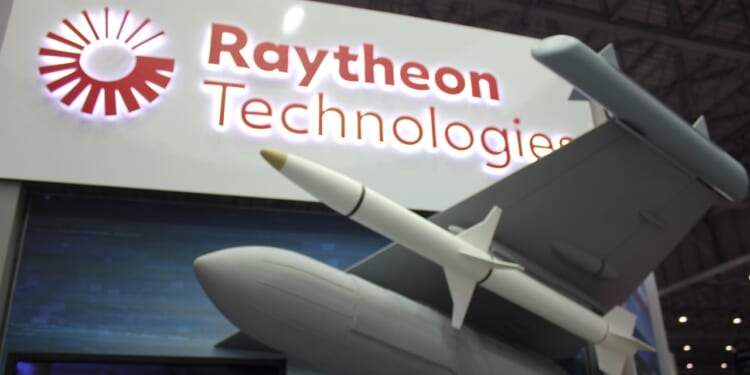China remains the key foreign impediment to America being able to revitalize its dwindling defense stockpiles of at least 12 critical weapons systems.
A recent Wall Street Journal essay highlights the ongoing crisis of America’s ever-diminishing stockpile of critical weapons. The Pentagon is in full panic mode, as the demands placed upon those stockpiles drastically increase and the ability to expand and replace depleted weapons, let alone maintain existing ones, has eroded far faster than the public realizes.
The report details how there are 12 critical weapons the Pentagon is pressing manufacturers to significantly boost production of—lest the United States, for the first time in the modern age, be unable to supply either its very needy allies or itself in any conflict soon. Weapons such as the SM-6, LRASM, JASSM, and PrSM missiles, as well as Patriot interceptors, are all depleting far faster than for what the Pentagon had planned.
Per the article, manufacturers are being told to create new production timelines that can achieve an increase of more than two times the output of these systems within six-to-24 months. Some ideas that have been floated are the infusion of private capital and licensing as means of overcoming the defense industrial base’s stagnant production timeline.
But all of this is wishful thinking, totally divorced from the sad reality of our moment.
Understanding Why the Acquisitions Process Is So Broken
The US defense industrial base has proven itself to be highly inefficient. And all one needs to do is to review open-source anti-corruption websites, such as the Project on Government Oversight or Open the Books, to see an endless array of provable cases of waste in the defense industrial base. But claiming that corruption and inefficiency are the only reasons for America’s utter inability to produce the weapons it needs, at the rate it requires, and the amount it seeks to better defend itself—and its allies—misses the forest for the trees.
The simple fact is that the basic, underlying infrastructure to support increased demand in the defense industrial base is nonexistent. It has faded, like so many other aspects of America’s once-mighty industrial base. What hasn’t been “streamlined” in the United States has been offshored to other countries. In fact, in 2023 Raytheon CEO Greg Hayes told CNBC that America “can de-risk” from its overexposure to China, but it “cannot decouple [emphasis added].”
Why not?
In Hayes’ estimation, it is “impossible” to decouple from China, due to the fact that America has an astounding $500 billion per year trade relationship with Beijing. And, as we’ve seen in recent months, at the crux of that trading relationship are things like rare earth minerals, which are literally the essential building blocks not only for most technology today, but specifically for advanced weapons of the kind that the US military relies upon.
What Hayes was telling his number one client—the US government—in 2023 is that picking a fight with China was tantamount to suicide, given the kind of headaches they can cause us with weapons manufacturing.
America Needs China’s Help to Defend Itself from China
First, a few other data points relating to Hayes’ 2023 statement. First, a July 2025 Government Accountability Office (GAO) investigation revealed a “dangerously high dependency” on Chinese materials for US weapon systems. The report details how faulty procurement systems often provide limited visibility into a component’s country of origin, allowing Chinese manufacturers to circumvent Pentagon quality and security controls—and allowing Chinese parts to become deeply embedded in the US defense supply chain.
Even before Hayes’ comments in 2023, back in 2022, the Biden administration ordered a halt to F-35 production. This was done after engineers detected Chinese-made magnets in the engines of the fifth-generation multirole stealth warplane. A subsequent deep-range study of the Pentagon’s gargantuan supply chain conducted by Govini determined that at least ten percent of all “Tier 1” subcontractors for American defense primes across critical mission areas rely on products from China.
What’s more, Govini detailed how this dependence is especially pronounced in key areas like missile defense and nuclear systems.
During the trade war initiated by President Donald Trump against China, it coolly responded by simply cutting off the Americans from accessing key rare earth minerals. This was an easy step for Beijing to take, considering that it dominates around 69 percent of the world’s known rare earth mineral supply and possesses more than 90 percent of the sophisticated rare earth mineral refining facilities in the world.
In short, China remains the key foreign impediment to America being able to revitalize its dwindling defense stockpiles of at least 12 critical weapons systems that both it and its allies require to have a chance of defeating their enemies. Yet Chinese-sourced materials are key for the creation of these weapons. And, thanks to a feckless and aggressive US foreign policy, China and Russia are now partnered in defeating what they view as an imperialistic, hubristic American “empire.”
Given this, and the ongoing trade war, why would Beijing’s rulers want to sell Americans the resources they know would be used to build the very weapons that threaten China’s good friends in Russia?
The Pentagon seemingly believes it can click its heels and wean the defense industrial base off key inputs from China. This suggests a lack of comprehension about how supply chains work and how business in a post-industrial economy like the United States is conducted. US defense officials have complained about Chinese integration into the defense industrial supply chain for over a decade.
A 2018 report in Bloomberg Businessweek, entitled “The Big Hack,” showcases how a Chinese firm named Supermicro made motherboards for US military server farms—and installed physical surveillance chips on those motherboards. And that’s just a vignette of the wider problems of having Chinese firms so enmeshed in the massive US defense industrial base.
Reshoring US Industrial Capacity Will Be Tough
But considering that the US offshored so much of its manufacturing capabilities to China, and that China can today supply advanced systems and materials on the cheap—allowing defense contractors to pocket the difference—defense contractors have an active incentive against changing their practices. And even if they wanted to change this, it is unclear if they could.
Then there’s the problems that come from being a postindustrial nation. Unlike during World War II, when there was real latent industrial capacity in the country that made it easy for America to become the “Arsenal of Democracy,” no such latent capability today exists. America’s once-productive “Rust Belt” is now blighted by American carnage as a result of the offshoring of US manufacturing.
President Trump first campaigned in 2016 on reconstituting this lost dynamism. As his experience has shown, though, it will take more than strong words and a plucky attitude. At least two generations have been lost to offshoring and its knock-on effects. Rebuilding that capacity—if it can be done at all—cannot be done anytime soon. It must be rebuilt from the ground-up.
But without that latent industrial capacity or even the workforce to support this renaissance in domestic manufacturing, the notion that Uncle Sam can easily expand production of its key weapons platforms—and maintain that increased production schedule—is fantastical.
A far better plan would be for America to work to end its foreign wars—and then assiduously devote the time and effort to rebuilding its industrial base as a whole. For the time being, at least, America cannot be the “Arsenal of Democracy” if its foreign policy keeps committing it to such wars—and its defense industrial base lacks the resources to fight them.
About the Author: Brandon J. Weichert
Brandon J. Weichert is a senior national security editor at The National Interest. Recently, Weichert became the host of The National Security Hour on America Outloud News and iHeartRadio, where he discusses national security policy every Wednesday at 8pm Eastern. He is also a contributor at Popular Mechanics and has consulted regularly with various government institutions and private organizations on geopolitical issues. Weichert’s writings have appeared in multiple publications, including The Washington Times, National Review, The American Spectator, MSN, The Asia Times, and others. His books include Winning Space: How America Remains a Superpower, Biohacked: China’s Race to Control Life, and The Shadow War: Iran’s Quest for Supremacy. His newest book, A Disaster of Our Own Making: How the West Lost Ukraine is available for purchase wherever books are sold. He can be followed via Twitter @WeTheBrandon.
Image: Shutterstock / Arnold O. A. Pinto.

















